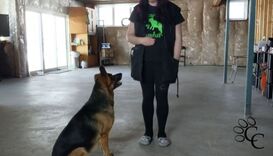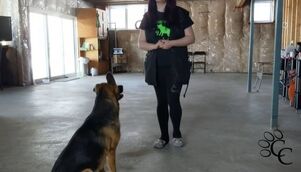

What started as a simple baby step stay in our basement turned into an end goal of dogs that will hold a stay in different places, with different distractions, and long enough to humor their owner who needs to take forever to get the perfect shot.
|
It's been said that anything worth doing is worth doing right. And what is right, in our books, is to use baby steps to achieve our goals. With anything, there are always steps to learn something. We don't just know how to do algebra. First, we learn our numbers, then adding, subtracting, multiplication and division. Then we get weird and start adding letters in. In order to be really good at advanced math, we have to master the basics first. Think of a marathon runner - they don't just become one overnight. As a baby, they start by pulling themselves around, then crawling, and finally, they take their first step. Once they are older and the desire to become a runner is born they start with small distances and build up stamina for greater lengths and durations. We have found the same theory applies to most any goals - personal or in dog training. Look at the end game and then break it down. What are the little steps that make up the big picture? Not sure how to do this?  Take the stay command for an example. The end goal is to have a dog that when asked is not going to move, no matter what's going on around it. We begin by teaching our dog a sit or lay down command.  Once they can reliably do this without moving we then ask them for a stay but we do not move. As long as the dog did not move it is still staying. After a few repetitions of this, we add 1 step. Sometimes, if it is a young puppy, a very excitable dog, or a dog you have done a lot of engagement and bonding with they will not want to stay and they will try and come with you. In this case, 1 step might be too much. We recommend telling them to stay, and then rocking back on one foot (a half step) and then coming back in and rewarding the dog if they stayed. Then you can move to adding a full step. If taking one single step is going good we can either add another step or increase the length of time we ask the dog to remain staying. We only want to pick one of these as we want our dogs to be successful. Slowly work on adding more steps, longer durations, and add in distractions. Sometimes as you increase the difficulty your dog may "break" their stay. Simply take them back to the starting stop and try again. If this happens more than once it means that you should take a one step back and work on that until they are a bit stronger at the distance or duration. This is totally normal and part of the baby step process of building a solid foundation. Continue this until you have the stay you pictured as your end goal. Any goal can and should be broken into steps. This makes achieving it much more manageable and if we are being honest, for us it helps the end goal to not seem as daunting or overwhelming to get to. When you work on individual baby steps you get to watch yourself and your dog making progress and celebrate along the way. We highly recommend keeping a training journal as well as videoing or taking photos of your training. This way you can monitor your progress, see all the baby steps, see where you are struggling and what you need to work on, and it is amazing to look back on afterward and see how far you have come.
What started as a simple baby step stay in our basement turned into an end goal of dogs that will hold a stay in different places, with different distractions, and long enough to humor their owner who needs to take forever to get the perfect shot.
1 Comment
7/4/2024 10:46:43 am
I wanted to express my gratitude for your insightful and engaging article. Your writing is clear and easy to follow, and I appreciated the way you presented your ideas in a thoughtful and organized manner. Your analysis was both thought-provoking and well-researched, and I enjoyed the real-life examples you used to illustrate your points. Your article has provided me with a fresh perspective on the subject matter and has inspired me to think more deeply about this topic.
Reply
Leave a Reply. |
AuthorSamantha is the Owner and face behind Canine Coaching. She believes all dogs (both young and old) are capable of learning and are happier being well-mannered members of the family! Samantha resides in Central Alberta with her Husband on their acreage with their two German Shepherds Tori and Baron. Archives
January 2022
Categories
All
|
|
Samantha Freschette - CPDT KA
403-348-9949 (call/text) [email protected] Bowden, Alberta Proudly serving Central Alberta! |
